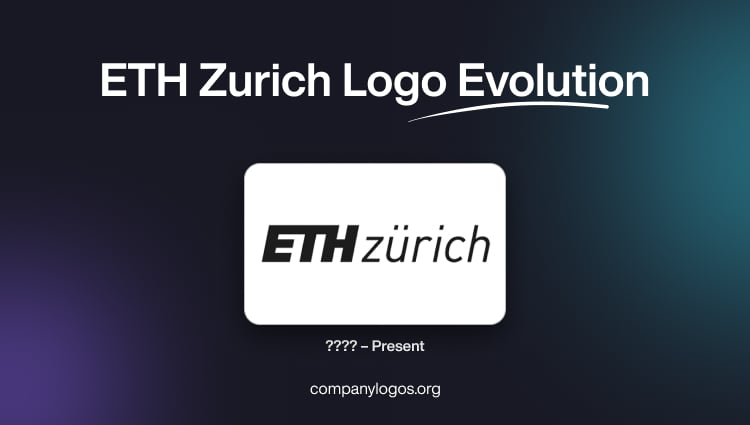
The famed Swiss-based academic institution ETH Zurich was established in 1855 as the “Eidgenössische Polytechnische Schule” (Federal Polytechnic School). It is known for producing a host of Nobel laureates and for conducting cutting edge research in a host of academic disciplines. Its earliest logos reflect the ethos typical of scientific institutions in 19th-century Europe. The article delves into the history and evolution of the ETH logo, among other details about the academic institution.
The Genesis of the ETH Zurich Logo (???? – Present)
The visual identity of ETH Zurich started with heraldic crests, which are no longer available. Over time, the logo design choices showcase the journey of the university from a local polytechnic to a world-leading academic institution. The timeline of the current logo is not known either. However, it characterises minimalism and features the name of the institution in a modern, bold, and geometric sans-serif typeface called DIN Next. The university has shunned ornamental design in favour of functional clarity.
The logo design features a black-and-white colour combination to ensure consistency and a neutral yet authoritative presence. In the wordmark, the first three letters “ETH” appear in uppercase and are connected at the top. They are thick, bold, and slightly italicised as well. The rest of the wordmark “zurich” is much smaller in size and written in thin lowercase, also italicised.

The Elements of the ETH Zurich Logo
Font
The typeface used to design ETH Zurich’s official logo is DIN Next. It is a modern, geometric sans-serif typeface that is consistently used across the university’s branding. DIN Next is chosen for its clear, neutral, and highly legible design. Besides, it supports the university’s focus on precision, scientific rigour, and engineering clarity.
Colour
The colour scheme for the ETH Zurich logo is black on white. This combination is used to maintain consistency and a formal, authoritative appearance across all platforms.
The History of ETH Zurich
ETH Zurich, aka Eidgenössische Technische Hochschule Zürich, was founded on 7 February 1854 by the Swiss Confederation as the Eidgenössische Polytechnische Schule (Federal Polytechnic School). It began offering courses from 16 October 1855, with lectures initially held in various locations across Zurich. The institution was created to support Swiss industry, train technical experts, and advance the nation’s infrastructure during a crucial period of industrialisation.
At its inception, it comprised six faculties. These included architecture, civil engineering, mechanical engineering, chemistry, forestry, and a combined department for mathematics, natural sciences, literature, social sciences, and political studies. Known informally as the “Polytechnikum” or simply “Poly”, ETH Zurich initially shared facilities with the University of Zurich.
Between 1905 and 1908, under the leadership of Jérôme Franel, the curriculum was restructured, and in 1909, the institution gained the authority to award doctorates. Two years later, in 1911, it officially adopted the name ETH Zurich. Over the decades, the number of departments expanded to reflect the advent of new disciplines, and today it includes sixteen departments.
From its early years, ETH Zurich earned a reputation for excellence. It became a driving force behind industrial and technological development in Switzerland and attracted some of the world’s greatest minds. They included, among others, Albert Einstein, who both studied and taught at the institution in the early 1900s. The university boasts an impressive record of achievement, with 22 Nobel laureates among its alumni and faculty.
The historic main building is an architectural landmark in downtown Zurich and remains an emblem of the institution’s heritage. At the same time, the modern Hönggerberg campus on the city’s outskirts offers state-of-the-art facilities. ETH Zurich has fostered a vibrant academic and cultural life. It nurtured traditions such as the annual Polyball, which dated back to the 1880s, and the popular SOLA relay sporting event. As a public university directly administered by the Swiss federal government, ETH Zurich continues to rank among the world’s top universities for scientific research and education.
Interesting Facts About ETH Zurich
- ETH Zurich was established as the Eidgenössische Polytechnische Schule (Federal Polytechnic School) and later became the Eidgenössische Technische Hochschule in 1911.
- The legendary physicist Albert Einstein studied at ETH Zurich. He graduated in 1900 with a diploma in physics and later returned as a professor.
- ETH Zurich has produced over 20 Nobel laureates, which include not only Einstein but also Wilhelm Röntgen (discoverer of X-rays) and Richard Ernst (NMR spectroscopy).
- ETH Zurich consistently ranks among the top universities worldwide. It is particularly strong in engineering, natural sciences, and technology.
- Most undergraduate courses are taught in German, while many master’s and doctoral programmes are offered in English to attract international talent.
- ETH Zurich is federally funded, and it provides resources and independence that help sustain cutting-edge research.
- The main building was designed by Gottfried Semper (the architect of the Semperoper in Dresden), and it is a Zurich landmark with a famous dome.
- ETH collaborates closely with global companies like Google, IBM, and Novartis. It fosters research partnerships and technology transfer.
- ETH Zurich is a leader in environmental science, climate research, and sustainable technologies, and it influences global climate policy.
- ETH Zurich operates museums, exhibitions, and public lectures. These include the focusTerra Earth Science Exhibition and the ETH Library.
- ETH has the historic Zentrum campus in downtown Zurich and the modern Hönggerberg campus, which is a hub for research and innovation.
- ETH hosts some of the world’s most advanced supercomputers. They support large-scale simulations and data analysis for scientific research.
Finally
The ETH Zurich logo reflects a careful balance between enduring tradition and continuous innovation. What began as a simple crest has grown into a nuanced brand identity that communicates prestige, clarity, and academic excellence worldwide. Although the previous logo variants are not available, and are considered more likely to be of heraldic origin, the present one is modern and minimalist.